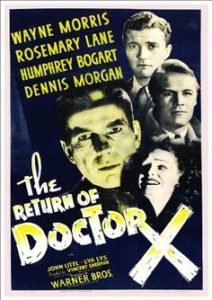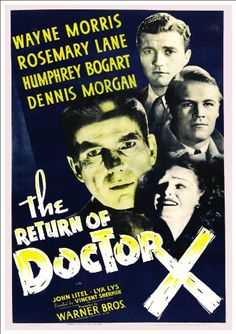
THE RETURN OF DOCTOR X (Warner Brothers, 1939) directed by Vincent Sherman, is in retrospect, not a sequel to the 1932 early two-strip Technicolor mystery, DOCTOR X (First National) that featured Lionel Atwill and Fay Wray, but actually a Grade Z programmer surprisingly headed by a very interesting cast of non-horror actors. Regardless of what’s displayed on screen, in capable hands this might have worked as one of the finer “B” films of the horror or science fiction genre. Production values, though, are on a larger scale than any poverty row horror film from Monogram Studios, and slightly beneath what Universal would start producing by the mid 1940s. THE RETURN OF DOCTOR X, however, as the title indicates, is a story about a scientist. The scientist in question is not Doctor X, but on a Doctor Francis Flegg (John Litel) whose profession is on blood experiments.
Plot: Walter Barnett (Wayne Morris), a hapless reporter from Wichita, Kansas, working for the Morning Dispatch in New York City, arranges for an interview with European actress, Angela Merrova (Lya Lys), currently staying at the Park Vista Hotel. Later that day, Barnett (whose spoken surname sounds more like Garrett) comes to her hotel room to find her dead, stabbed through the heart. After telephoning the news to the city editor about his discovery, the news about Merrova’s death makes the front page. However, rather than getting a promotion, Barnett is called to his editor’s office to find not only Angela Merrova to be sitting there very much alive (in spite of her dead white appearance), but to be suing the Morning Dispatch of $100,000 for damages on her reputation. Fired from his job, Barnett comes to Jules Memorial Hospital where he tells his intern friend, Michael Rhodes (Dennis Morgan), of the circumstances, which Rhodes finds hard to believe. Stanley Rodgers (John Ridgely), a blood donor specialist scheduled to arrive at the hospital for a transfusion prior to an operation performed by Doctor Francis Flegg (John Litel), is found dead. Barnett notices Rodgers has died in the same fashion as Angela Merrova. Through a series of investigations, it is learned that any patient with Type One blood (the same blood type of Rodgers) has disappeared from the hospital, leaving the victims drained of their blood. As Rhodes goes to Doctor Flegg for a visit, he’s followed inconspicuously by Barnett. Before meeting with Flegg, Rhodes is met by Flegg’s laboratory assistant (Humphrey Bogart), whose ghost-like facial features and acquiring his icy cold and shake indicates that there’s something entirely strange and mysterious about him. As for Barnett (peeking through the windows), believing he’s seen this man before, goes through the file room of the Morning Dispatch looking for clues. He discovers through old newspaper clippings that Flegg’s assistant bears some connection to the recently executed Doctor X.
Featured in the supporting cast are: Rosemary Lane (Joan Vance, the student nurse); Huntz Hall (Pinky, the newspaper copy boy); Charles C. Wilson (Detective Roy Kincaid); and Vera Lewis (Nurse Sweetman). Olin Howland playing the morgue attendant is very amusing with his “dead-on” sense of humor.
Zombie-like creatures, including Bogart (billed as Marshall Quesne, but who refers himself to the name that sounds more like “Kane,” sporting glasses and a streak of white hair down his head) and Lya Lys, in desperate need for specific rare blood types in order to stay alive and roaming the city, makes THE RETURN OF DOCTOR X quite interesting in plot though sometimes unbearable with its over abundance of “comedy relief” by Wayne Morris. What makes this “thriller” watchable is the unusual casting of the soon to be “superstar” Humphrey Bogart, then a resident Warner Brothers stock player notable for playing gangster-types. While Boris Karloff, who specialized in roles as this, was appearing in programmers at Warners (1938-40), makes one wonder why he wasn’t awarded the role given to Bogey instead. Maybe because that’s to be expected. With Bogart, it’s not, which is why it makes fantastic viewing during of 62 minutes. Another point of interest is finding Bogart’s name billed third during the opening credits, and star credit for its closing cast listing. With its sci-fi influence, THE RETURN OF DOCTOR X is campy, often amusing, and seldom scary. It does offer Rosemary Lane a rare opportunity enacting the frightful heroine quite commonly found in horror films, as well as an opportunity to belt out a scream or two while tied onto a laboratory table as she’s to become the next victim of losing her blood. In traditional Bogart form, the story does find time for some gun play and car chases down the city streets. As for Dennis Morgan, who began his movie career for MGM under the name of Stanley Morner, makes a fine serious-minded secondary character in his Warner Brothers debut. He would soon rise to leading roles within a few years, becoming best known for his frequent partnership opposite Jack Carson in a series of Technicolor musical-comedies throughout the 1940s.
THE RETURN OF DOCTOR X, thus far, has never been distributed on video cassette. It currently plays on Turner Classic Movies, especially in October in collaboration of Halloween and other horror flicks.

